
Dracula tourism is a type of cultural tourism involving travel to sites associated with Dracula and his real or imaginary travels. There is Dracula tourism mainly in Transylvania, Romania, but also in Ireland and in the United Kingdom.

Dracula tourism is a type of cultural tourism involving travel to sites associated with Dracula and his real or imaginary travels. There is Dracula tourism mainly in Transylvania, Romania, but also in Ireland and in the United Kingdom.
The most well-known Dracula tourism locations to visit in Romania are:
Although Dracula tourism is a popular attraction in Romania, government leaders prefer other attractions within the country to be Romania's image. The National Tourism Masterplan restricted any Dracula theme parks from 2007 to 2026 to be initiated. [1] The Romanian government views Dracula tourism as a false image of Romania, as Dracula was from a fictional novel rather than a piece of Romanian history. Despite this, Dracula tourism has made an impact on the country's economy in the past and currently there are multiple attractions within the country. [1]
Initially Romania's government did not view Dracula tourism as problematic due to the positive economic change. Romania's historical Vlad the Impaler was the focus of the tours. [2]
In 2019, a 7-Day Halloween in Transylvania Dracula tour including 3 Halloween parties was awarded "2019 Tour of the Year" by TourRadar at Festival category. [3]
In 2011 Dracula Tours in London were included in "The world's best vampire-spotting locations" by Lonely Planet. [4]
In 2011 Dracula Tours in Transylvania were included in "Top 5 Offbeat Travel Tours" by Tourism Review. [5]
In 2007 Dracula tour-Halloween in Transylvania was included in a "Top 10 Must-Do Adventure" by Fodor's. [6]
Dracula Park was a theme park proposition by Radu Florescu in 1995. [7] The idea was to attract tourists worldwide and bring a larger audience to Romania and its identity with the fictional Transylvanian vampire.
There were over 5,000 share holders and multiple attractions were planned for the park, including a hotel. [8]
The theme park idea was rejected until 2001, six years after the initial proposal. [7]
Dracula Park gained widespread attention in its development. There was controversy on the theme park and if it would be harmful to Romania's image, and the Dracula Park project was dropped. [9]
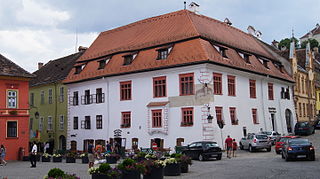
Sighișoara is a municipality on the Târnava Mare River in Mureș County, central Romania. Located in the historic region of Transylvania, Sighișoara had a population of 23,927 according to the 2021 census. It is a popular tourist destination for its well-preserved old town, which is listed by UNESCO as a World Heritage Site. The town administers seven villages: Angofa, Aurel Vlaicu, Hetiur, Rora, Șoromiclea, Venchi, and Viilor.

Bran Castle is a castle in Bran, 25 kilometres (16 mi) southwest of Brașov. The castle was built by Saxons in 1377 who were given the privilege by Louis I of Hungary. It is a national monument and landmark in Transylvania. The fortress is on the Transylvanian side of the historical border with Wallachia, on road DN73.
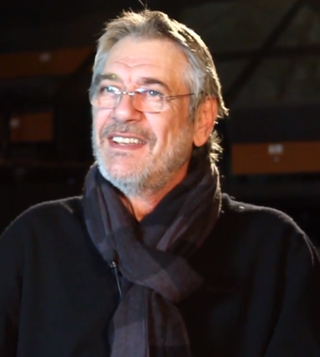
Marcel Iureș is a Romanian actor. He is one of Romania's most acclaimed stage and film actors. He has acted in films and on stage both in Romania and internationally, and has played at least ten roles on Romanian and British television. His work includes voiceovers for Disney and computer games. Iureș is the president and a judge of the Anonimul International Film Festival and also the president of Ideo Ideis Festival.
Largely as a result of the success of Bram Stoker's Dracula, Transylvania has become a popular setting for gothic horror fiction, and most particularly vampire fiction. In some later books and movies Stoker's Count Dracula was conflated with the historical Vlad III Dracula, known as Vlad the Impaler (1431–1476), who though most likely born in the Transylvanian city of Sighișoara, ruled over neighboring Wallachia.

Vlad III, commonly known as Vlad the Impaler or Vlad Dracula, was Voivode of Wallachia three times between 1448 and his death in 1476/77. He is often considered one of the most important rulers in Wallachian history and a national hero of Romania.
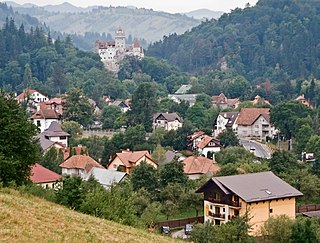
Bran is a commune in Brașov County, Transylvania, Romania. It is about 25 kilometres (16 mi) southwest of the city of Brașov and consists of five villages: Bran, Poarta, Predeluț (Kispredeál), Șimon (Simon), and Sohodol (Szohodol).

Romania's tourism sector had a direct contribution of EUR 5.21 billion to the Gross Domestic Product (GDP) in 2018, slightly higher than in 2017, placing Romania on the 32nd place in the world, ahead of Slovakia and Bulgaria, but behind Greece and the Czech Republic. The total tourism sector's total contribution to Romania's economy, which also takes into account the investments and spending determined by this sector, was some EUR 15.3 billion in 2018, up by 8.4% compared to 2017.
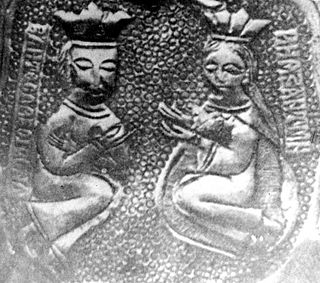
Vladislav II was a voivode of the principality of Wallachia, from 1447 to 1448, and again from 1448 to 1456. The way Vladislav II came to the throne is debatable. The most accepted view is that Vladislav assassinated Vlad II Dracul, ruler of Wallachia, and was subsequently placed on the throne by John Hunyadi, on the other, Vladislav II was helped by the Ottomans to replace Dan III which was assigned by the Hungarians.

Snagov is a commune, located 40 km (25 mi) north of Bucharest, in Ilfov County, Muntenia, Romania. The commune is composed of five villages: Ciofliceni, Ghermănești, Snagov, Tâncăbești, and Vlădiceasca. Snagov is a tourist and spa resort, but the necessary infrastructure has regressed after 1989. At the 2021 census, the commune had a population of 8,331; according to the 2011 census, 92% of the population is ethnic Romanian.
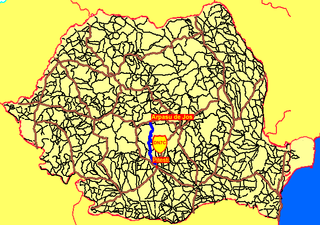
The Transfăgărășan or DN7C is a paved mountain road crossing the southern section of the Carpathian Mountains of Romania. It has national-road ranking and is the second-highest paved road in the country after the Transalpina. It starts near the village of Bascov, near Pitești, and stretches 90 kilometres (56 mi) to the crossroad between the DN1 and Sibiu, between the highest peaks in the country, Moldoveanu and Negoiu. The road, built in the early 1970s as a strategic military route, connects the historic regions of Transylvania and Wallachia.
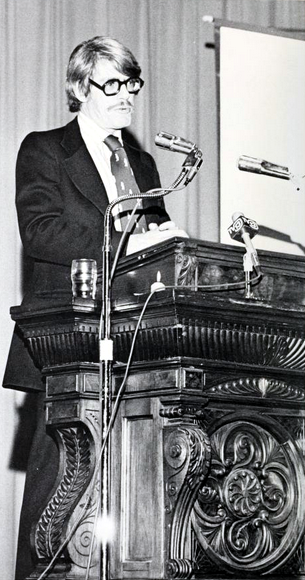
Radu Florescu was a Romanian academic who held the position of Emeritus Professor of History at Boston College. His work on Vlad Dracula includes a series of bestselling books that he co-authored with his colleague Raymond T. McNally. Along with serving as Director of the East European Research Center at Boston College, Florescu was also a philanthropist and an adviser to Edward Kennedy on Balkan and Eastern European affairs. At the time of his death, Radu Florescu was considered the patriarch of the Florescu family.

Corvin Castle, also known as Hunyadi Castle or Hunedoara Castle, is a Gothic-Renaissance castle in Hunedoara, Romania. It is one of the largest castles in Europe and is featured as one of the Seven Wonders of Romania.

Poenari Castle, also known as Poenari Citadel, is a ruined castle in Romania which was a home of Vlad the Impaler. The citadel is situated on top of a mountain and accessed by climbing 1,480 concrete stairs.
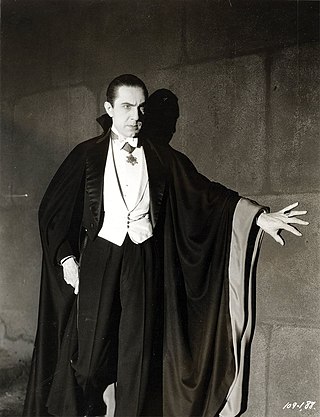
Count Dracula is the title character of Bram Stoker's 1897 gothic horror novel Dracula. He is considered the prototypical and archetypal vampire in subsequent works of fiction. Aspects of the character are believed by some to have been inspired by the 15th-century Wallachian prince Vlad the Impaler, who was also known as Vlad Dracula, and by Sir Henry Irving, an actor for whom Stoker was a personal assistant.

Dracula, also known as Bram Stoker's Dracula and Dan Curtis' Dracula, is a 1974 British made-for-television gothic horror film and adaptation of Bram Stoker's 1897 novel Dracula. It was written by Richard Matheson and directed by Dark Shadows creator Dan Curtis, with Jack Palance in the title role. It was the second collaboration for Curtis and Palance after the 1968 TV film The Strange Case of Dr. Jekyll and Mr. Hyde.
The character of Count Dracula from the 1897 novel Dracula by Bram Stoker, has remained popular over the years, and many forms of media have adopted the character in various forms. In their book Dracula in Visual Media, authors John Edgar Browning and Caroline Joan S. Picart declared that no other horror character or vampire has been emulated more times than Count Dracula. Most variations of Dracula across film, comics, television and documentaries predominantly explore the character of Dracula as he was first portrayed in film, with only a few adapting Stoker's original narrative more closely. These including borrowing the look of Count Dracula in both the Universal's series of Dracula and Hammer's series of Dracula, including include the characters clothing, mannerisms, physical features hair style and his motivations such as wanting to be in a home away from Europe.

Dark Prince: The True Story of Dracula, alternately titled Dracula: The Dark Prince and Dark Prince: Legend of Dracula, is a horror-war television film, which premiered in the United States on the USA Network on Halloween, October 31, 2000. It is about Vlad III Dracula, "the Impaler", the historical figure who gave Bram Stoker's Dracula his name.
The Transylvanian Society of Dracula (TSD) is a cultural-historic, non-profit, non-governmental organization. Its members include Romanian and international scholars, folklorists, historians, esoterists, writers, cultural anthropologists, and individuals interested in comparative religion, magic and mythology. The TSD organizes scholarly activities both in Romania and abroad, as well as tours to sites of TSD interest in Romania. Some high ranked Romanian members make money out of the touristic activities of the organization, through the Company of Mysterious Journeys tourist agency. Modifications to this agency have occurred since the founder Nicolae Paduraru died. The Halloween 2011 tour, for example, did not include Bran Castle or Curtea Veche -in spite of what was published in their web site-, but it included a beauty pageant. One of the Romanian members of TSD working at the agency was one of the presenters of such pageant.

Castle Dracula is the fictitious Transylvanian residence of Count Dracula, the vampire antagonist in Bram Stoker's 1897 horror novel Dracula. It is the setting of the first few and final scenes of the novel.
Eva is a fictional comic book character created and published by Dynamite Entertainment. She is a vampire hunter who is the daughter of Count Dracula. She first appeared in Dynamite's Army of Darkness comics during the Ash vs. The Classic Monsters storyline.